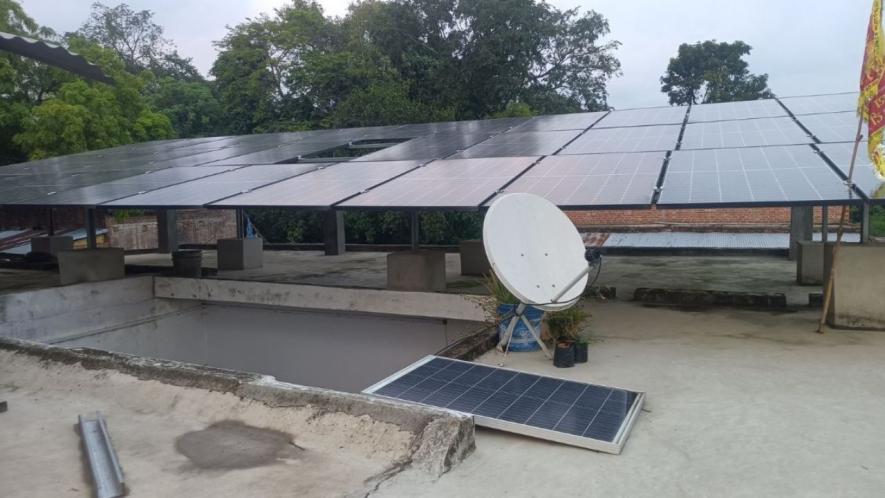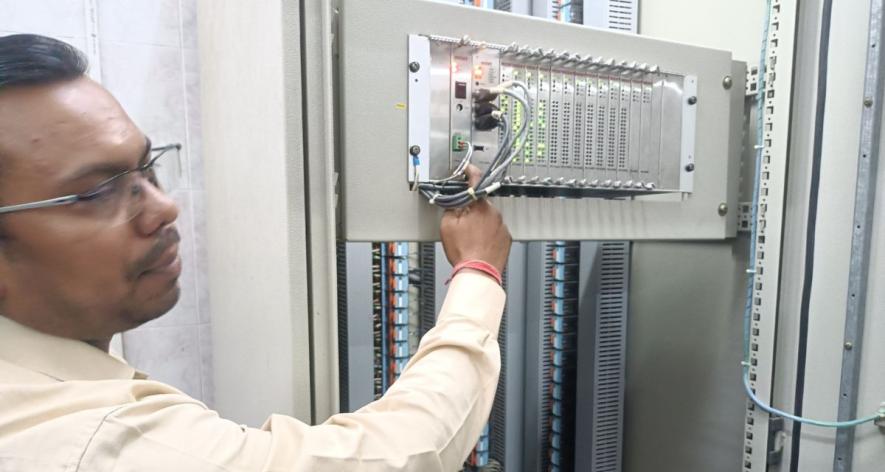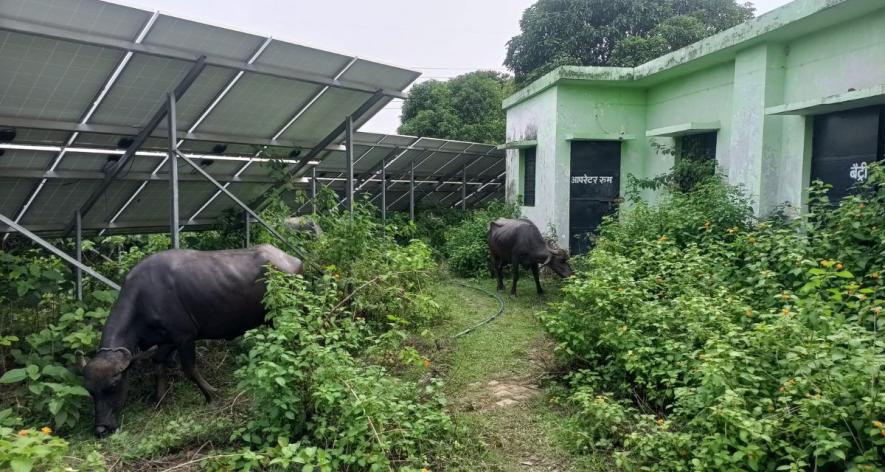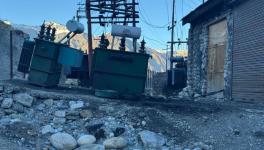How Shortage of Trained Hands has Emerged as the Weakest Link in UP’s Solar Story

Rooftop panels for a flour mill in Brahmavali, Sitapur (Photo - Ramji Mishra, 101Reporters)
Sitapur, Uttar Pradesh: On the last day of July, Ashok Kumar (45), a farmer from Budaun district, had been waiting for a solar pump mechanic for nearly a month.
His irrigation system, installed under the PM Kusum Scheme C-1, had been faulty for weeks. “The mechanic comes from Mathura,” he told 101Reporters. “He arrived four days after the first complaint, found some equipment faulty, and then it has been almost four weeks with no proper fix. Sometimes the mechanic’s visit can take many days to happen.”
Kumar’s complaint is hardly unique. Farmers across Shahjahanpur, Sitapur, and Lakhimpur districts report similar delays. As solar energy expands rapidly across Uttar Pradesh, the shortage of trained technicians and service staff has emerged as the weakest link.
The promise of Surya Mitras
To address this shortage, the Ministry of New and Renewable Energy (MNRE) launched the Surya Mitra Skill Development Programme in 2015. Between 2015 and 2022, 51,529 Surya Mitras were trained across India. According to the National Institute of Solar Energy (NISE), the number has now crossed 57,000, trained through 187 partners, 426 registered centres, and 1,912 batches. Uttar Pradesh alone has 38 training centres.
The state government has set itself a target of training 30,000 Surya Mitras by 2026, aiming for at least one in every block. Yet the numbers fall far short of demand.
So far, only around 5,805 have completed the course statewide, compared to over 25 lakh solar installations and 1.8 lakh new rooftop registrations. Of them 2,115 have been placed.
The three-month course involves 600 hours of classroom and practical training. Candidates must have completed Class 10 and ITI training in trades like electrician or wireman. Placement assistance is promised, and instructors insist there is no shortage of jobs.
At Sitapur’s Government ITI, instructor Rajesh Kushwaha said: “If someone wants a job, there is 100% placement. Many people, however, prefer self-employment or do not want regular jobs. Technical training ensures employability, but applications are still fewer than expected.”
Kushwaha added that broader skills fetch more opportunities: “If someone can make a fan, their scope is limited. But if they can also wire it, repair a cooler, and fix other equipment, jobs multiply. We send our electricians to work on solar grids so they can add that to their skill set.”
Kanhiya Lal, who trained in Ambedkar Nagar after a BSc, said he had been waiting since January for a promised placement. “The company keeps saying they will call us. I am hopeful, but it has been months.”
Pranavchand, another trainee, said: “I feel confident about my knowledge, but I cannot leave home for work. The training was good, especially since it was free, but jobs are far away.”
Akash Singh, trained in Ghazipur, said some classmates had received offers. “A few got jobs with a 10,000-15,000 rupee salary. But most postings are in other districts. Very few of us can go that far.”
Trained for waiting
Even where Surya Mitras are trained, service delivery often falters. Companies empanelled under government schemes are expected to provide after-sales support through service centres. But many such centres exist only on paper.
In Shahjahanpur, the MNRE website listed a Premier company centre in Puwayan tehsil with contact details for a man named Parmajit. When contacted, Parmajit admitted his service centre had been shut for years. In Budaun, another listed centre had also long closed.
In practice, local electricians and entrepreneurs fill the gap. Arif Khan, who runs a service centre in Shahjahanpur, said: “We have to follow company rules strictly. Customers get angry, and we also have no flexibility. Even then, we get 30 calls daily, sometimes covering 10 companies with just five staff. Many issues we solve on the phone, others require travel.”
Khan said trained recruits rarely apply: “Uneducated people come asking for high salaries. We want properly trained workers, but they don’t show up.”
Shakeel Khan in Budaun, who once ran an authorised service centre, now works independently. “Many companies give poor support. When locals face small issues with other brands, we help them out. We train recruits ourselves for ten days before sending them on fieldwork,” he said. Shakeel himself studied only till high school, with no formal training, but has been working in the sector for years.
Rakesh Kumar Dubey, a vendor in Lucknow, said the economics of this exercise are difficult to explain. “I can employ 18 people at most. For trained workers, I pay up to 18,000 a month. But often we rely on untrained hands because demand is high and trained people leave.”

Smart Grid Control Centre at IIT Kanpur's Department of Electrical Engineering (Photo - Ramji Mishra, 101Reporters).
Learning on the job
In Sitapur, “Kirti Traders” sells solar panels on subsidy and credit. But its staff mechanics, who handle customer complaints, have learned only by watching others. “We regularly seek customer feedback,” admitted manager Mukesh Rawat.
Similar improvisation is visible elsewhere. In Shahjahanpur, Anoop Kumar, 23, a diploma holder in mechanical engineering but without solar training, works at a service centre. “I learned on the job,” he said. “I handle two or three complaints daily—often minor issues like dry runs that require restarting the system during cloud cover. Some days I travel 400 km across districts to attend complaints.”
In Mahmudpur, the village water tank runs on solar panels. Operator Balram has never heard of the Surya Mitra course. “I just learned by watching others. If something stops, we call a local mechanic.” At Narni, pump operator Govind echoed him: “We manage daily running. For bigger faults, we wait for someone from the town.”
Even large projects depend on untrained hands. At the Patabozh solar grid in Sitapur, Manvendra, who earns Rs 9,000 a month, said he was recruited directly without formal instruction. “They showed me how to switch on and off, clean the panels, and note readings. That’s all.”
The cost of this makeshift system is borne by farmers and villagers. In Sitapur’s Brahmavali village, Upendra Tiwari invested Rs 5.61 lakh in a set of 455-watt panels for his flour mill and home batteries. Installed in December 2023, the system runs barely four hours a day instead of the promised nine. “Once it broke for a day, but the mechanic came after 15 days. We still haven’t repaid our loan. Proper installation would have saved diesel and electricity costs,” he said.
Some community grids have collapsed altogether. In Patabozh, a Rs 2 crore-grid that once supplied free power to 460 homes shut down in 2023 due to faults and the absence of trained staff. In Lakhimpur’s Chandan Chowki village, another grid ran for four to five years before closing amid thefts and untrained management.
There are rare exceptions. Kanduni village still runs a functional automatic grid staffed by six trained workers, including three Surya Mitras. Their presence underlines what others lack.
“Panels need dusting twice a month, and thermal imaging detects faults. Solar plants demand trained designers, installers, and operators,” said engineer Dhananjay Kumar. Without such expertise, India’s solar ambitions rest on shaky ground.

The defunct grid at Patabozh has now become a grazing ground (Photo - Ramji Mishra, 101Reporters).
Skill gap
Government officials acknowledge the shortage. Purushottam Kumar Mishra, Deputy Agriculture Director in Shahjahanpur, said: “In 2023-24, nearly 700 solar pumps were provided under the PM Kusum scheme, dropping to 350 in 2024-25. All complaints are forwarded to companies. Those not performing well face blacklisting. Currently, Premier, Prakash Gold, and Shakti are approved suppliers.”
From the state’s side, Uttar Pradesh New and Renewable Energy Development Agency Director Inderjit Singh said multiple training schemes are underway: Surya Mitra, Surya Sakhi, and manufacturing courses linked to universities. “UP has already met 1,100 MW rooftop and 2,743 MW utility capacity targets. As adoption grows, over 30,000 technicians will be trained to meet demand.”
Industry experts explained that manpower must grow in parallel with capacity. Anil Kumar Chaudhary, Chief General Manager of Energy Efficiency Solar Limited, said trained personnel are critical for new demands like solar cold storage. “As solar energy use increases, the number of trained personnel will increase; it won’t increase all at once.”
Some private companies are reluctant to discuss the issue. A representative of HFM Solar Ltd, when asked about wages and placements, declined to share details, saying he would “get back later” but never did.
At the Indian Institute of Technology, Kanpur, a smart grid managing 120 connections is operated by just three trained staff, blending automation with manual oversight. Demonstrations like this point to how the future might look, but only if human capacity keeps pace with solar rollout.
Back in Budaun, Ashok Kumar is still waiting for his pump to be fixed. For farmers like him, solar’s promise of cheaper irrigation and reliable power remains tied to the availability of trained hands. Uttar Pradesh may lead in installations, but until the state invests equally in its workforce, the solar dream will keep running on fragile ground.
(Ramji Mishra is a freelance journalist and a member of 101Reporters, a pan-India network of grassroots reporters.)
Get the latest reports & analysis with people's perspective on Protests, movements & deep analytical videos, discussions of the current affairs in your Telegram app. Subscribe to NewsClick's Telegram channel & get Real-Time updates on stories, as they get published on our website.
























